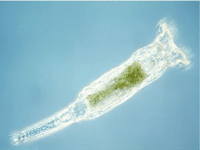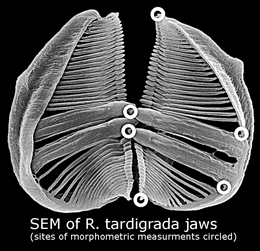100 million years without sex: COI clustering in bdelloid rotifers challenges theories of how species are formed and maintained
 Why are there species? The usual answer is sex: reproductive isolation maintains differences between species and reproductive mixing maintains similarity within species. According to recent work with bdelloid (the “b” is silent) rotifers, a group of microscopic invertebrates thought to have adopted asexuality 100 million years ago, sex is not necessary! In September 2005 Hydrobiologia 546:29, researchers at the University of Arizona analyzed mitochondrial COI of 102 females of 21 morphologically defined species of bdelloid rotifers, including many sympatric morphospecies. Contrary to predictions of evolutionary theory for asexual organisms, Birky et al show that these are 21 independently evolving clades, with small differences within and large differences among lineages, the same patterning seen in COI analyses of sexual reproducing species. Also contrary to predictions, the Ka/Ks ratio (expressed/silent mutations) indicates that COI is subject to strong selection. [In asexual organisms, there is less need for sampling multiple genes because the entire genome is a single linkage unit. Thus genetic differences in COI are expected to reflect evolutionary history of the organism, i.e. the “gene tree” is expected to be the same as the “species tree.”] (For fun see Birky lab bdelloid video!)
Why are there species? The usual answer is sex: reproductive isolation maintains differences between species and reproductive mixing maintains similarity within species. According to recent work with bdelloid (the “b” is silent) rotifers, a group of microscopic invertebrates thought to have adopted asexuality 100 million years ago, sex is not necessary! In September 2005 Hydrobiologia 546:29, researchers at the University of Arizona analyzed mitochondrial COI of 102 females of 21 morphologically defined species of bdelloid rotifers, including many sympatric morphospecies. Contrary to predictions of evolutionary theory for asexual organisms, Birky et al show that these are 21 independently evolving clades, with small differences within and large differences among lineages, the same patterning seen in COI analyses of sexual reproducing species. Also contrary to predictions, the Ka/Ks ratio (expressed/silent mutations) indicates that COI is subject to strong selection. [In asexual organisms, there is less need for sampling multiple genes because the entire genome is a single linkage unit. Thus genetic differences in COI are expected to reflect evolutionary history of the organism, i.e. the “gene tree” is expected to be the same as the “species tree.”] (For fun see Birky lab bdelloid video!)
 In April 2007 PloS Biology researchers from University of Milan, Italy, Imperial College London, University of Cambridge, and Royal Botanic Gardens, Kew analyze morphometric and molecular data of a comprehensive international sampling of Rotaria sp. bdelloid rotifers. All 9 morphologically defined taxonomic species form monophyletic clades in genetic analysis. Multiple clusters in several morphospecies show distinct morphometric measurements of mouth parts, suggesting these represent cryptic species with ecological specialization. Fontaneto et al observe “bdelloids display the same qualitative pattern of genetic and morphological clusters, indicative of diversification into independently evolving and distinct entities, as found in sexual clades” and conclude “this refutes the idea that sex is necessary for diversification into evolutionary species.”
In April 2007 PloS Biology researchers from University of Milan, Italy, Imperial College London, University of Cambridge, and Royal Botanic Gardens, Kew analyze morphometric and molecular data of a comprehensive international sampling of Rotaria sp. bdelloid rotifers. All 9 morphologically defined taxonomic species form monophyletic clades in genetic analysis. Multiple clusters in several morphospecies show distinct morphometric measurements of mouth parts, suggesting these represent cryptic species with ecological specialization. Fontaneto et al observe “bdelloids display the same qualitative pattern of genetic and morphological clusters, indicative of diversification into independently evolving and distinct entities, as found in sexual clades” and conclude “this refutes the idea that sex is necessary for diversification into evolutionary species.”
In these studies, COI sequences accurately identify bdelloid rotifer species, further demonstrating the robustness of DNA barcoding. What is scientifically exciting is how broad application of standardized, minimalist genetic analysis (aka DNA barcoding), combined with traditional morphologic and ecologic study, is providing radical new insights into biology.
This entry was posted on Friday, May 4th, 2007 at 10:44 am and is filed under General. You can follow any responses to this entry through the RSS 2.0 feed. Both comments and pings are currently closed.